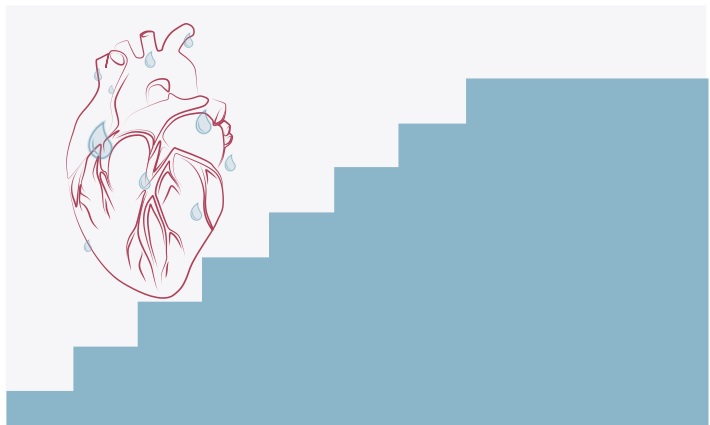Cutting-edge therapy at a high price
Left ventricular assist devices (LVADs) have transformed the treatment landscape of heart
failure. As the number of implants continues to increase, clinicians will have to integrate dedicated
programmes in their clinics and be actively involved in the care of patients on LVAD support.
Heart failure is one of the most common
cardiovascular conditions worldwide. The
estimated prevalence of heart failure is
increasing at epidemic proportions. By the end of
2014, 6.5 million Americans ≥ 20 years of age had
been diagnosed with heart failure. This prevalence is
projected to increase to > 8 million by the year 2030.
(Heidenreich et al. 2013). Data from the NHLBI-sponsored
CHA, ARIC and CHS cohorts indicate that heart
failure incidence approaches 21 per 1000 people
older than 65 years (Huffman et al. 2013). The total
costs for HF are projected to reach $69.7 billion by
2030, which represents an increase of 127% from
2012 (Benjamin et al. 2018).
Approximately 50% of heart failure patients have reduced ejection fraction, and 10% of these
patients experience refractory heart failure symptoms
(New York Heart Association functional class
IIIb to IV, Stage D), yielding an estimated cohort of
200,000 to 250,000 patients. These patients are
typically referred to cardiac transplant centres, where
they undergo evaluation to determine their candidacy
for heart transplantation. The short- and longterm
outcomes following cardiac transplantation
have been exceptional, with a median survival of
10.7 years (Stehlik et al. 2011). The major limitation
to cardiac transplantation has been the insufficient
donor supply, which is currently limited to
approximately 2,500 hearts annually in the United
States. Obviously, transplantation is not available for the majority of patients with advanced disease.
Fortunately, mechanical circulatory support with the
implantation of cardiac assist devices has emerged
as a novel therapeutic option for patients with
refractory symptoms despite optimal medical and
conservative treatment.
Left Ventricular Assist Devices
Left ventricular assist devices (LVADs) have revolutionised
the management of patients with advanced
heart failure, providing an alternative to heart transplantation.
LVADs were initially implanted as a bridge
to transplant, aiming to reduce the high mortality
rates among hospitalised patients awaiting donor
hearts. However, the paucity of donor organs alongside
a substantial increase in the burden of comorbidities
and the ageing of the heart failure population
has put the focus to non-transplant surgical
therapies for advanced heart failure. LVAD therapy
was shown to improve survival and quality of life,
either as a bridge to transplant or as a destination
therapy (Slaughter et al. 2009; Aaronson et
al. 2012). Following FDA approval for destination
therapy (DT) in 2010, LVAD implantations have
rapidly increased. The proportion of patients allocated
to DT increased from 19.6% during the period
2008-2010 to 45.7% of all implants in 2014. The
miniaturisation of devices, the evolution of device
technology and the improvisation of the operative
techniques as well as better patient selection and
complication management have led to a significant
improvement in survival rates. The 8th Interagency
Registry for Mechanically Assisted Circulatory
Support (INTERMACS) report on > 20.000 LVAD
implantations from 2006 to 2016 announced 1-year
survival of 81% and 2-year survival of 70% (Kirklin
et al. 2017). Nowadays, LVAD therapy constitutes
an established treatment option for well-selected
patients with advanced heart failure. As a result, the
number of transplant and non-transplant centres
integrating LVAD programmes in their facilities is
rapidly expanding, and a further increase in device
implantations is anticipated in the near future.
Economic impact of LVAD on healthcare
Despite these advantages, LVAD therapy is accompanied
by a disproportionately high resource
consumption and has an immense economic impact
on the healthcare system. This results from the
frequent hospital readmissions, the broad spectrum
of severe device-related complications and the Despite these advantages, LVAD therapy is accompanied
by a disproportionately high resource
consumption and has an immense economic impact
on the healthcare system. This results from the
frequent hospital readmissions, the broad spectrum
of severe device-related complications and the need for a dedicated team of qualified healthcare
workers in order to ensure appropriate long-term care
in the outpatient setting. Previous analyses have
demonstrated that LVAD was accompanied by volatile
increases in healthcare expenses, compared to
heart transplantation. Compared to non-bridged
heart transplant recipients, receiving an LVAD as
a bridge to transplantation increased survival, with
greater associated cost (range, $84964 per life-year
to $119574 per life-year for high-risk and low-risk
patients, respectively). Open heart transplantation
increased life expectancy and was cost-effective (8.5
years with <$100000 per quality-adjusted life years
[QALY] relative to medical therapy), but LVAD either
as a bridge to transplantation (12.3 years at $226
000 per QALY) or as destination therapy (4.4 years at
$202000 per QALY) was not cost-effective (Alba et
al. 2013; Baras et al. 2016). These conflicting interests
are reflected to an ongoing dialogue between
healthcare policymakers, hospital leaders, and frontline
clinicians, aiming to counteract healthcare
disparities in a cost-effective manner and improve clinical outcomes of this devastating disease.
Under these circumstances, clinics pursuing to
initiate LVAD programmess are confronted with
a challenging environment and have to take into
consideration various aspects of this exceptional
mode of therapy before moving to capital investments.
In general, an LVAD programme is considered
a challenging endeavour with regard to receiving
funding, administrative support, and local acceptance
from affiliated institutes and healthcare
providers. Hereafter, we summarise some aspects
from our own experience:
- Ideally, an LVAD programme should be part of
an interdisciplinary heart failure unit consisting
of a cardiology and a cardiac surgery department
with an adequate number of potential
LVAD candidates.
- Considering the multi-organ manifestations
of advanced heart failure and the broad spectrum
of non-surgical interventions indicated in
this patient cohort, the candidate centre should
be able to provide interventional and surgical
cardiac procedures, cardiac electronic device
implants and intensive care. A dedicated outpatient
clinic is part of the required infrastructure
in order to provide high-quality care of the
ambulatory patients on the long term.
- The physician leadership team is the core of the
LVAD project. An experienced heart failure cardiologist
and a cardiothoracic surgeon with expertise
in mechanical circulatory support should
supervise all aspects of device implementation,
including patient selection, staff training,
quality controls, and cost-effectiveness.
- A qualified team of surgeons, heart failure
cardiologists, and nurses familiar with the
complexity of LVAD therapy should be of high
priority. Two VAD coordinators should oversee
the entire process from candidacy to followup
care and take on administrative and organisational
tasks. Staff training in special skills
and familiarity with psychosocial, technical and
pharmaceutical issues is of paramount importance
for all parties. Rehabilitation physicians
should be part of the caring team and stay
interconnected with the implantation clinic if
not regionally located.
- At last, an in-hospital heart transplant
programme or a transplant centre affiliation
is vital for patients who are or may become
eligible for bridging therapy and should be
offered transplantation candidacy. Participation
in a palliative care network or at least an on-site consulting service should be available
for the end-of-life care of LVAD patients.
LVADs have transformed the treatment landscape
of heart failure and are now adopted for longterm
ambulatory support of patients with advanced
disease. As the number of implants is anticipated
to rise, clinicians in administrative positions will be
surged to integrate dedicated programmes in their
clinics and be actively involved in the care of patients
on LVAD support. Consequently, all aspects of this
mode of therapy will have to be considered, in order
to provide optimal care at a reasonably acceptable
cost.





